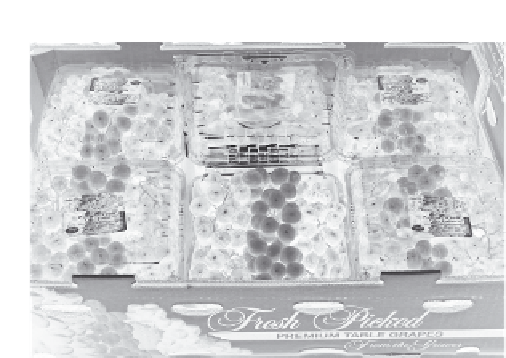Agriculture Reference
In-Depth Information
whereas the tough skins of Black Corinth and Thompson
Seedless usually prevent sugaring (Winkler
et al
. 1974).
Ecchymosis is when the raisins contain more than 16%
water and are stored in bags or in deep bins, the lower part
is pressed and the skin may be interrupted. Under these
conditions the syrup migrates out of the raisin. Very soon it
takes a dark colour and a lot of yeasts etc. start to ferment
the molasses.
Pests, moulds and mycotoxins
A wide range of pests and diseases may be found on dried
grape products if the product is not treated chemically with
insecticidal compounds or is not protected by suitable
packaging. Typical fungi include
Penicillium
,
Aspergillus
,
Cladosporium
,
Erotium and Alternaria
spp. Pests (insects
and mites) may attack the grape berry before, during and
after drying. Insecticide treatments before harvest may
control some of these pests post-harvest (Buchanan
et al
.
1984); however, attentions should be paid to the fate of
these chemical as drying can increase pesticide residue
levels fourfold (Cabras
et al
. 1998). A biocontrol method
with a granulosis virus has been shown to be highly
effective against
Plodia
spp (Vail
et al
. 1991) and attempts
have been made to combine effective packaging with
parasitic wasps to control the almond moth
Cadra cautella
in commercially packaged raisins (Cline & Press 1990).
Ochratoxin A and aflatoxins may be found in dried
grape products and methods for measuring concentrations
of Ochratoxin A in these products and aflatoxin have been
described (Bacigalupo
et al
. 1994; MacDonald
et al
. 1999).
Figure 9.1
Packaging three colours of grapes
(rainbow pack) is becoming very attractive to
consumers.
consumer preference for seedless cultivars (Perl
et al
.
2000) and in some countries (e.g. the United Kingdom) the
market for seeded table grapes has contracted substantially.
Cultivars
The major cultivar of table grapes is probably Italia
(Muscat) with around 700 000 tons produced per year in
Italy in the early 1990s; the main table grape cultivars
grown in France are Chasselas, Muscat de Hambourg and
Alphonse Lavallée (Vidaud
et al
. 1993). Another important
cultivar is Regina Bianca also known as Razaki in Turkey
and Rosaki in Greece. In California, which produces 90%
of US table grapes, the major cultivars are 'Thompson
Seedless' ('Sultanina') and 'Flame Seedless', marketed
mostly during the summer months. The early season
market in the Coacheilla Valley is dominated by 'Perlette',
'Sugraone' ('Superior Seedless'), Midnight Beauty and
Flame Seedless. 'Princess', 'Ruby Seedless', 'Crimson
Seedless' and 'Autumn Royal' make up the bulk of the
remaining production. There is also increasing production
of the seeded 'Red Globe' cultivar which is important for
export in the mid-to-late season. The Chilean and Spanish
industries are being developed based on California cultivars
while the South Africa grape industry has its own cultivars
such as Sunred Seedless, Regal Seedless, La Rochelle,
Dauphine, Bonheur and Bien Donné (ARC 2001).
POST-HARVEST TECHNOLOGY FOR
TABLE GRAPES
Introduction
Table grapes are a high-value fresh-fruit commodity.
Consumers will pay a premium for a quality product that
has a display value as well as being a convenient and
tasty fruit for consumption. 'White' (green/yellow) and
red/purple/'black' cultivars are internationally popular
(Figure 9.1). China grows by far the most fresh table grapes
in the world. In 2006 China produced over treble the
amount of table grapes (6.5 million MT) grown by the next
largest producer, Turkey (USDA 2007). In both cases, the
majority of this fruit is consumed internally.
World export volumes of table grapes are in the order of
2.73 million MT with the main exporter countries being, in
descending order, Chile, Italy, the United States, South
Africa, Mexico, the Netherlands, Greece and Turkey (FAO
2002). In many major importing markets, there is a
Maturity and quality indexes
The table grape is a nonclimacteric fruit with a relatively
low rate of physiological activity. Optimal flavour attributes
are usually obtained at commercial maturity. The main
maturity index is the sugar content, determined as the %






























